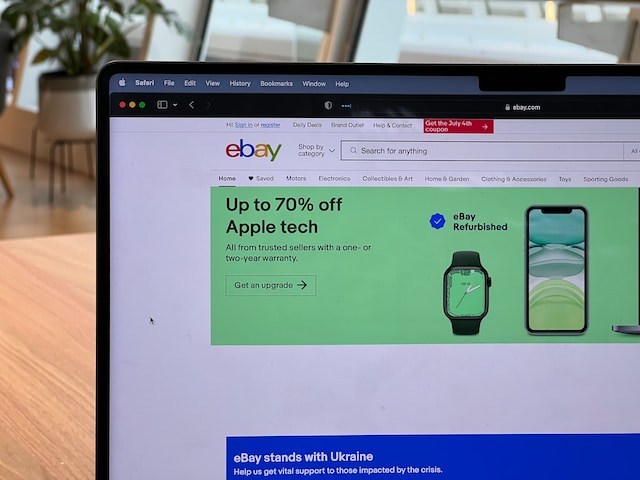
In today’s digital age, online marketplaces have revolutionized the way we buy and sell products. Among these virtual marketplaces, eBay stands out as a pioneer and a global leader. With millions of active users and an extensive array of products available, eBay has become a go-to platform for both buyers and sellers. However, mastering eBay can be a daunting task without the right knowledge and strategies. In this blog post, we’ll delve into the world of eBay, offering you valuable tips and tricks to become a savvy eBay user. Whether you’re a seasoned eBay pro or just starting your online selling journey, these insights will help you navigate the platform with confidence and succeed in online buying and selling.
Navigating the eBay Landscape: Getting Started
Navigating the eBay landscape as a beginner can seem like stepping into a bustling marketplace with no map. But fret not; getting started on eBay is simpler than you might think. First, create your eBay account, providing accurate information. Next, familiarize yourself with the eBay website or mobile app interface. Explore the search and filter options to find the items you desire. When it comes to listing items for sale, ensure you provide detailed descriptions and clear images to attract potential buyers. Understanding the basics of eBay is the crucial first step in your journey to becoming a confident user of this global online marketplace.
Selling Like a Pro: Maximizing Your eBay Listings
In the fast-paced world of online selling, it’s not uncommon to encounter periods when your eBay sales slow down. When this happens, don’t be discouraged; instead, use this time as an opportunity to fine-tune your strategies and revitalize your eBay listings.
- Revise and Refresh Your Listings: Take a closer look at your existing listings. Are your product descriptions clear and detailed? Are your images high-quality and appealing? Consider updating your listings with fresh photos and revised descriptions to make your products more enticing to potential buyers.
- Price Competitively: Research the competition and adjust your prices accordingly. Sometimes, a slight price reduction can make your listings more attractive to buyers. Keep in mind that eBay often features items with competitive pricing more prominently in search results.
- Optimize Keywords: Ensure your listings include relevant keywords that buyers might use when searching for your products. A well-optimized title and item description can significantly improve your visibility on eBay’s search engine.
- Offer Special Promotions: eBay provides tools to create special offers, like discounts or bundled deals. These promotions can grab the attention of potential buyers and stimulate sales during slow periods.
- Utilize Social Media and Promotion: Promote your eBay listings on social media platforms or through your own website if you have one. Expanding your reach beyond eBay can bring in new customers.
- Experiment with Auctions: Consider using the auction format for select items. Auctions can create a sense of urgency and competition, potentially boosting interest and bids.
- Provide Exceptional Customer Service: Good feedback and positive reviews can go a long way in building trust with buyers. Ensure you’re responsive to inquiries, provide prompt shipping, and maintain open communication with your customers.
- Evaluate Your Inventory: Sometimes, slow sales can be a sign that your inventory needs a refresh. Consider discontinuing underperforming items or introducing new, in-demand products.
- Monitor Trends and Seasonality: Be aware of seasonal trends and demand fluctuations in your niche. Adjust your inventory and marketing strategies accordingly to capitalize on these patterns.
Remember that slow periods are a part of every seller’s journey on eBay. By proactively addressing the situation and implementing these strategies, you can turn sluggish sales into an opportunity for growth and improvement. Stay persistent and adaptable, and your eBay business will thrive in the long run.
Avoiding Common Pitfalls and Staying Safe
When you’re selling on eBay, it’s crucial to be mindful of common pitfalls and prioritize your safety throughout the process.
Here are some essential tips to help you steer clear of potential issues and maintain a secure selling experience.
Guard your personal information carefully. Use eBay’s messaging system for communication with buyers instead of sharing your email or phone number. Keep your address private and consider using a P.O. box or an alternative address for shipping when possible.
Prior to shipping an item, verify that payment has been processed and cleared. Be cautious of counterfeit payment notifications or deceptive PayPal emails. Always ensure that the funds are in your account before dispatching the item.
Thoroughly review the feedback and ratings of potential buyers. Be careful when dealing with buyers who have a history of problematic transactions or negative feedback from other sellers. Maintain open and transparent communication with buyers. Address any questions or concerns promptly and professionally. Resolving issues amicably can prevent negative feedback and disputes.
By staying informed and vigilant, you can minimize risks when selling on eBay and ensure a secure and successful selling experience. While the majority of eBay transactions proceed smoothly, being prepared for potential challenges is always a wise approach.
Final Remarks
In conclusion, eBay offers endless opportunities for both buyers and sellers to connect and transact. By mastering the tips and tricks outlined in this blog post, you’ll be well on your way to becoming a savvy eBay user. Whether you’re searching for unique treasures, starting an online business, or simply looking to streamline your buying and selling experience, eBay has something for everyone. Armed with the knowledge from this guide, you can confidently navigate the eBay marketplace, secure great deals, and build a successful online presence. Happy buying and selling!






